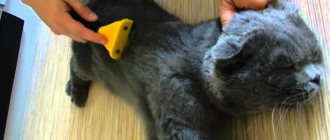Holding a cat like a dog is not a very pleasant situation for the cats themselves. This is why it can be difficult to lift and hold.
But there are times when you need to do this, such as to put him in a carrier or during a vet visit, and it's important to do it correctly so that your cat doesn't get hurt or do this to you, perhaps because she's scared. So, let's look at some tips together on how to pick up a cat without scaring it.
Adviсe
If there is no other way out and you need to take the cat by the scruff of the neck, this must be done very carefully so as not to cause any inconvenience to the animal. It is worth monitoring his reaction; movements should be confident, skillful, and not clumsy, because cats are very sensitive to the movements and actions of their owner and other people around them. Wariness, fear, and concern for the cat should be left for the future, when the job is done. If the cat senses this in the owner, it will begin to wriggle out and try to escape, thereby hurting itself. You need to take your pet correctly. To begin with, you should feel for a good fold on the back of the neck so that it is convenient to grab it. Next, slowly lift the cat, but only a little, to look at the reaction. At this moment, the cat's paws should still touch the ground.
If the animal is frozen and does not show aggression, you can slowly continue to raise it. It is very important to grab only a good, large fold, since if the hand grabs little skin, the cat may slip out.
https://youtube.com/watch?v=aursPvtW5b8
Read also: How to set a password on iPhone
Why you can't drag a cat by the scruff of the neck
Thanks to the innate reflex, the kitten, when the mother cat drags it, grabbing it by the scruff of the neck, relaxes its body, and also tucks its hind legs and tail. Temporary paralysis is explained by pinching of a bundle of nerves located on the back of the neck. It is much easier for a cat to move a relaxed and non-resisting baby to a safe place. During carrying, the cat does not cause any harm or pain to its cub. The scruff of a cat's neck is considered the most painless part of the body. However, adult pets cannot be lifted or dragged by the scruff of the neck.
Cats drag kittens, biting the scruff of the neck with their teeth
Reasons are physiological
The ban on lifting an adult cat by the scruff of the neck is explained by physiology:
- A mature animal's skin is rougher and less elastic than that of a small kitten. The skin does not stretch well and may even tear.
- The neck muscles may become damaged (stretched or torn), since the pet is already quite heavy.
- The rough skin becomes very tight and puts pressure on the throat, making it difficult for the cat to breathe.
- A sharp grab by the scruff of the neck can even damage the spine (in rare cases).
How to properly hold a cat in your arms
When holding your cat close to your chest, be guided by its habits and reactions. Every pet and owner is unique, and so will your relationship. However, there are a number of universal recommendations that will help you and your cat understand each other and enjoy communication.
- Hold your pet lightly against your chest, with its head and neck raised up - this is how the animal is most comfortable.
- The cat should sit on one of your hands, and it is best to support it under the chest with the other hand. If she doesn’t like it that way, she will take a comfortable position herself - the main thing is not to interfere with her initiative.
- Never lift your pet by the scruff of the neck! A mother cat carries her kittens this way, but this is only possible due to the small weight of the kitten. An adult animal weighs much more, so it will be painful and uncomfortable.
It is better not to handle newborn kittens at all - there is a risk of skeletal deformation. In addition, some cats are capable of abandoning their cubs due to the foreign smell.
Lifting a cat by the scruff of the neck: is it possible or not?
You cannot lift an adult cat by the scruff of the neck (by the scruff of the neck). The first point is weight. Adult cats can be heavy, up to 15 kg. If you lift a cat by the scruff of the neck and hold it in this position, muscle damage may occur due to the uneven distribution of weight. The second point is that it is painful and unpleasant for the animal. An exception is that a cat can be held in place by the scruff of the neck, provided that it has good paws on the surface. This is done in a veterinary clinic during medical procedures or at home if the cat needs to be given medicine, but it resists.
Photo gallery: illustration of the process of how to pick up a cat
Show your intentions to pick up the cat
The cat already knows that you are nearby, now show her your friendliness. If the cat is nervous, it is better to choose a different time for close communication. Place your left hand under the cat’s belly behind the front paws
Use your other hand to grab the cat's hind legs.
Carefully lift the cat
Hold the cat lightly against your chest
Watch for changes in your cat's behavior when she doesn't want to be held
Carefully lower the cat to the floor, do not throw it even from a small height
It is strictly not recommended to pick up an adult cat by the scruff of the neck.
Supervise children when they are holding a cat
How should you keep your pet?
You also need to know how to hold your pet correctly. It is recommended to follow the following rules:
- Place the animal near the chest so that its head is slightly higher than the level of the body.
- Gently hold the cat close to you, avoiding too much squeezing. Excessive pressure will not only cause her discomfort, but can also cause pain, and in some cases lead to injury, especially if we are talking about a kitten whose skeletal system has not yet fully strengthened.
- Make sure your pet's body is straight. It is not recommended to allow the animal's body to sag and place it upside down. An uncomfortable position will cause the cat, experiencing discomfort, to begin to violently break free from your hands. If you don't let her go right away, she can bite and scratch her owner.
How to explain to a child why you should not hit an animal
Some children at a certain age exhibit some aggressive behavior towards our little brothers. This in no way indicates that the child is depraved or has a bad character. It’s just that a period of personal development has come in his life. He is trying to prove to himself and others that he has some weight in the world. And this proof is most often expressed in tangibly changing something in him through his actions. Throwing cups and plates off the table quickly gets boring, the little man moves on to animate objects.
Subconsciously, the child chooses for his experiments creatures that are weaker and cannot, in his understanding, respond well. So poor cats come across the path of these brats, forced to endure the domination of a person who has just come out of diapers. Parents are required to take some measures and explain to their child why cats should not be hit. After all, this self-affirmation can turn into a habit and, over time, spread to people. And on the other hand, not every cat will tolerate beating. Even well-deserved ones, let alone just like that.
The best lesson for a child, of course, would be some response from the offended animal. But cats, unfortunately, do not know how to lightly spank. If they scratch or bite, it is with all their might. And here the task of parents is to explain why they should not touch animals, not so much for humane reasons as for fear for the well-being of their own children. Probably not all mothers know that cats aim to scratch specifically in the eye. In their opinion, this is the most vulnerable place.
There are several options to influence a child's behavior. Which one to choose depends on each specific case. For some children, it is enough to explain how painful the cat is, that she is crying and offended. That she might die if she thought the child didn't love her. For three-year-old children, who have not yet experienced our cruel world, this option is very effective. They are compassionate and kind by nature.
If the child is too aggressive and sometimes received punishment for mischief, then in this case there is nothing left but to intimidate with the most suitable argument from the parents’ point of view. If a schoolboy beats animals, then talking here is useless. Most likely, he is simulating the behavioral algorithm adopted in his family. And you can’t do it without a child psychologist.
Man by nature is obliged to be humane towards weaker creatures. And the question of why cats should not be beaten is not even worth raising. One popular wisdom says: anyone can offend the weak, but only the weak can want to offend the weak. And we in our world should not be weak. Otherwise, there will always be someone weaker who will offend us.
Animal instincts
Not every four-legged pet enjoys the fact that its owner limits its movements. There are some cats that resist with all their might anyone who tries to pick them up. And once in the strong hands of the owner, they try to escape as quickly as possible.
Everyone is familiar with the phrase: “The cat walks on its own.” It is based on natural instincts that have been preserved in their genotype even after a large amount of time since their domestication. This is the main reason why pets don’t like being in their owner’s hands.
Cat owners strive to pick up and pet their pet as often as possible. To please both the person and the animal, you should examine in detail the question of how to properly hold a cat in your arms.
Second phase
The first stage of acquaintance requires caution, since the cat can attack a person and scratch him. Check in first, demonstrating friendliness and respect
To find out the cat's mood, place a palm above its head. If he nuzzles or purrs, he allows himself to be petted.
If the cat rubs against his legs and purrs, then perhaps he is bored and wants attention. Unconditional trust is evidenced by the fact that the animal sits comfortably on the person's lap.
A cat rubbing against its legs is a good sign
Next, they ensure that the cat climbs onto her lap on her own.
Then they carefully teach her to limit her movements and lift her into her arms. At first, to avoid injuries in the form of scratches and bites, wear long sleeves and do not walk with bare legs or bare feet.
You can't look a cat in the eyes
When the cat begins to calmly perceive the presence of the new owner, you can spend some time with her - for example, 30-60 minutes, for example, reading a book. And the cat is offered toys that are sold in a pet store.
Choosing a toy for a cat
Fear of touch takes a long time to heal, but the new owner must be patient. At first, the cat is not picked up and contact is not required if the animal seeks privacy. Light touches are only possible if the pet itself approaches the person.
Nervous excitement should always be a signal to stop contact. And it manifests itself like this:
- the tail trembles;
- ears drooped towards the head;
- shoulders and limbs tense;
- pupils are dilated.
Full pupils and pinched ears are a sign of tension
You should not immediately try to pick up the cat, as this will most likely result in injuries - bites and scratches.
First, the cat is accustomed to your hand by placing it palm down on the floor; you can place the cat’s favorite toy nearby. You need to wait until the cat comes up and rubs itself on your arm or leg. In this way, she wants to make sure that the object present is not dangerous. If a person initiates contact, the animal may respond with an attack.
If the cat attacks, pick him up early
If the pet has given the go-ahead, the palm is slowly raised to eye level and held in this position for a while. Then they begin slow stroking. You need to stop before the cat gets tired of close contact with a person.
Features of some breeds
A cat's dislike for physical contact may be due to the characteristics of its breed. British Shorthair and Scottish Fold and Straight cats often behave very independently, which is also reflected in their reluctance to sit in their hands. The phlegmatic British and Scots do not really need affection, they are self-sufficient and usually do not go on their own, they only allow themselves to be stroked. Wayward Maine Coons can also exhibit similar qualities. Among cats of these breeds there are also more sociable individuals, but exceptions only confirm the rule.
Interpretation according to zodiac signs
You can figure out and understand why a small gray kitten is dreaming based on the interpretation of the dream according to the dreamers’ zodiac signs:
- Aries - deterioration of health;
- Taurus - profit;
- Gemini - short-lived luck;
- Cancer - vain dreams;
- Leo - financial difficulties;
- Virgo - new apartment, house;
- Libra is a disease;
- Scorpio - brilliant success;
- Sagittarius - movement towards the goal;
- Capricorn - financial gain;
- Aquarius - lie;
- Pisces is a new addition to the family.
In addition to the signs of the Zodiac, you can pay attention to other details of the dream, such as the days of the week, the condition of the animal, and its behavior. There are several dream interpreters who have differing opinions about the meaning of sleeping with a gray cutie.
Why doesn't a cat like to be held?
Animal psychologists say that if domestic cats could choose, most would prefer to never be picked up or picked up. Even if a pet trusts a person, he still feels complete comfort only by standing with all four paws on the ground. So you shouldn’t be surprised if your pet protests against “handles” - such behavior for cats is more the norm than a deviation.
How to properly hold a cat in your arms
Reasons why a cat does not want to be held:
- Distraction. If a cat sees something interesting - a bird outside the window or a moving shadow - it will want to explore what it saw and will jump from your hands.
- Strong smell. A cat’s sense of smell is 14 times more sensitive than a human’s: a person’s brain has 5-20 million cells responsible for sensing and recognizing odors, while a cat has 60-80 million. The animal does not like any strong aromas, especially spices, citrus fruits, perfumes, washing powder , alcohol. You can learn more about what smell cats don’t like in our separate article.
A cat's nose is many times more sensitive than a human's
- Fright. Frightened by screams, sudden movements or sounds, or strangers, the cat will try to hide in a secluded place, so it will not let itself into your hands or will try to escape.
- Fear of heights. As already mentioned, a cat is completely calm only when standing on a hard, level surface. Raised above the ground, she may be afraid of losing her balance and falling.
- Street past. If you pick up a pet on the street, it has not grown up accustomed to affection, and attempts to touch it may be perceived as a threat to its own safety.
The street cat sees danger everywhere
- Resentment. Cats have long memories. If you or the previous owner beat the cat or shouted at it, the animal will refuse to come into your arms because of past grievances.
- Strangers or children. The animal may not trust strangers, and may be afraid of children.
- Features of the breed. Short-haired British cats and fold-eared cats especially do not like to be handled; their breed is characterized by independence and restraint. Maine Coons can also refuse contact from their owners. The most sociable are mongrel pets who have no street history.
- Diseases of the musculoskeletal system. A cat that suffers from arthritis, for example, is not always comfortable in a person's arms.
How to recognize arthritis in cats
Of course, the character traits of a particular animal can also determine its love or dislike of close tactile contact.
Don't you dare squeeze my majesty!
There are closed, self-sufficient or fearful cats that from birth cannot tolerate physical contact and do not like to communicate and play. It also happens that the animal simply does not show the initiative, but does not mind if it is picked up and stroked. And sometimes a cat simply does not accept a family member or guest, and this “brutal verdict” is not subject to appeal. If you wish, you can tame an animal and instill a sense of trust in it, but you will have to spend a lot of time and labor. The most important thing is not to force the cat into affection and physical contact.
Ways to train a kitten
Sometimes you can’t just calmly sit a kitten in your arms, because it gets scared and, even when it recognizes the person, continues to struggle. In order for a pet to be willingly given into the owner’s hands, it is necessary to accustom it to this, if it itself does not show a desire to actively make contact. As soon as the kitten realizes that communicating with the owner, when he takes him in his hands, brings him pleasure, the baby himself will strive to cuddle the person. Be sure to hold the kitten correctly, caress the pet and talk calmly to it. It’s very good if the cat starts playing while in your arms.
shutterstock
The kitten will quickly stop being afraid to be handled if you use one of the training methods below.
Using the characteristics of animal physiology. After the kitten has eaten well, it begins to feel sleepy, since maximum energy is spent on digesting food. If the animal is warm and comfortable at this moment, it will begin to experience special pleasure. The owner may well provide the pet with the illusion that he is lying next to his mother if he picks up a well-fed, dozing kitten and cuddles him, but without squeezing. Gradually, the baby will get used to the fact that sitting in your arms is very pleasant and safe. Talk. Monotonous, affectionate conversation with the kitten gradually begins to relax it
At this moment, the owner has the opportunity to gently stroke the pet behind the ear or in the throat area. If the kitten reacted calmly to such affection, you need to place your palms on its sides
If the baby does not break free here, he is carefully picked up. When the kitten tries to escape, you should not restrain it by force. Such sessions must be repeated several times a day, until the baby agrees to stay on the owner’s lap. Lure with a treat. This method is most suitable for kittens who are particularly freedom-loving and cannot combine being held in their arms with pleasant sensations. Using a treat, the owner lures the pet onto his lap. While the kitten is eating the treat, you need to stroke it on the back, but under no circumstances hold it by force. Gradually, the baby will get used to the fact that it is pleasant to be held and will actively seek the company of the owner. Overcoming the fear of heights. As strange as it may sound, some cats are terrified of heights. Because of this, when a kitten is picked up incorrectly and he perceives what is happening as floating in the air, he experiences a severe shock. This phenomenon can be prevented simply by starting to hold the baby correctly. Then his fear of hands will go away. You need to take the kitten with one hand under the armpits, and place the other under its hind legs. After this, the baby should be held close to you, but not squeezed. If the fear is panicky, then first you need to accustom the kitten to your hands while sitting on the floor. Training in the game. This method is suitable for active kittens who are not yet ready to exchange free time for affection. When playing with such a baby with a toy, you should gradually pull it onto your lap. After the kitten jumps into your arms, you need to let him catch the toy here and enjoy the catch. While the kitten is playing in your arms, you can pet it. Gradually, such games with jumping into hands will lead to the fact that the animal will not only completely get used to the hands, but will not be able to do without affection and close contact with a person. With this nature of the pet, you should often allow the cat to sit in your arms while playing with the owner.
The choice of method depends on the individual characteristics of the kitten, and each owner must evaluate for himself which method is optimal in his case. In principle, accustoming a kitten to affection cannot fail, you just don’t need to stubbornly follow a method that is not suitable, but need to be creative in your approach.
shutterstock
Is it possible to tame an adult cat to a new owner?
A cat tolerates a change of owner more easily than a dog. The exception is socially oriented breeds, for example, Oriental Siamese. They will gradually become affectionate with their new owners, but the first one is the only one for life.
The best way to train, even for a sexually mature individual, is not food, but play. First, an adult cat must get used to the territory. It is better to leave your pet to explore its new home on its own, and after a while offer some food from your hands. Just like a treat. At the same time, do not forget to talk measuredly, but not to stroke.
As soon as the cat gets used to it a little, you can:
- lightly scratch a chair or furniture - so that the cat reacts to the sound near the owner;
- roll a ball or ball of wool near you, inviting you to play;
- “drive” a candy wrapper.
The cat quickly joins the game. After a while, you should again give a piece of food from your hand and praise it.
You can't hit a cat!
Cats are not used to obeying, therefore, their owners often have difficulty raising their pets. The biggest mistake in raising wayward animals is the use of physical force. You can't hit cats. This method cannot solve the problem; you will only lose her trust. The animal will begin to associate you with pain.
If you punish a cat for bad behavior, the results will only be visible the first time. Over time, such “education” ceases to work completely.
Aggression for educational purposes on the part of the owner is assessed by the animal in its own way; the cat may lose its pride and you will no longer have a normal relationship with your pets.
How to properly hold a cat in your arms and pick up an animal so as not to cause inconvenience?
How many cat owners, when picking them up, think about the fact that their inept actions could cause them discomfort, and in some cases, harm? Meanwhile, you need to be able to do it correctly. To ensure that the pet does not break free, calmly walks into the owner’s arms and gladly receives affection from him, you need to take into account several nuances. Each owner of such a pet is recommended to know not only how to properly hold a cat in his arms, but also how he should be picked up from the floor and what actions should be avoided.
Cat in the hands of a child
As a rule, cats react negatively when they are picked up by a child. Why? There are several reasons:
- children do not know how to recognize a pet’s reactions and let him go in time;
- children do not know how or are physically unable to hold a cat correctly, causing it pain and inconvenience;
- children can chase the animal to catch it.
The result of such communication often becomes stress and trauma for the cat and the child. Therefore, it is important to tell your child how to interact with an animal correctly.
Vasya, you definitely don’t want to be held in your arms
Step 1. Do not allow “unsupervised” contact between the child and the cat. Explain to the baby all the pet’s reactions, tell them how to establish contact correctly.
Step 2. Show how to properly pick up and hold a cat in your arms. It is better not to lift a cat for a child under 5-6 years old - he simply will not be able to hold it correctly.
Step 3: Explain how to tell if your cat is unhappy and wants to be let go.
Explain to your child how to understand that the cat is unhappy
Step 4. Show how to properly release the cat without dropping it on the floor.
Step 5. Tell us what not to do with a cat (chase, pull the tail, catch, hold by force, hit).
Important! Teach your child not to use his hands as a toy when interacting with the cat, otherwise the animal will decide that biting and scratching is completely acceptable.
At what age should you start raising a kitten?
Raising a kitten should begin before two months from birth. Usually during this period the baby is still in the nursery or with the breeder, as he needs his mother and milk feeding. The cat instills basic skills and rules of behavior. The breeder teaches the kitten to toilet, and the mother teaches other cat skills. With such a kitten there are fewer problems, it is easier to train them to the new requirements of the owners. The situation is much more complicated with kittens found on the street - these are ill-mannered cats that have not received the necessary skills for living with humans, but the situation can be corrected.
One of the main requirements is to let the kitten get stronger, get good health and immunity. Caring for an animal will give it good health and proper psyche
You need to start accustoming him to the tray from the very first days, but with caution, without using physical force in case of mistakes
At the age of 3-4 months, the kitten is very active, plays a lot, plays pranks and even misbehaves. During this period, it is worth showing rigor and patience. You need to demonstrate a firm tone, but without punishment or violence.
At approximately six months, puberty begins. This applies to both male and female cats. Under the influence of hormones, the pet's character changes, not always for the better, the animal becomes disobedient. But everything returns to normal around the age of one year, when the kitten becomes a young adult cat.
Features of some individual breeds: Sphynx, Scottish cats and others
Some breeds require special care.
British and Scottish cats
The British and Scots need special attention to their ears - they should always be clean, with trimmed tassels. It is also necessary to pay special attention to their coat - it is recommended to comb them at least twice a week, for at least half an hour, using massaging movements. By the way, these are the only representatives of short-haired cats who like to be combed against the grain.
Scottish fold kitten
Sphinxes
These cats are hairless and require special care. Firstly, they sweat, so they need to be wiped with a damp sponge at least once a day. Secondly, kittens of this breed do not have eyelashes, so something often gets into their eyes - they are washed either with black tea or special eye drops. Thirdly, the ears of sphinxes must be inspected daily and cleaned at the slightest hint of dirt. It is also necessary to remove hairs from the skin of sphinxes if they appear.
A very small Don Sphynx kitten
Long-haired breeds
If you have a Siberian or Persian cat, Maine Coon or other kitten with increased hairiness, you will have to purchase a lot of different scratchers and brushes, and devote enough time to combing procedures. So, a mitten brush will remove lost hairs, a slicker will remove excess undercoat, a sparse comb will comb out the main coat and massage your pet, a frequent brush will be useful for the softest places - the tummy, the inside of the paws and the area under the tail. Also, representatives of long-haired breeds often need additional vitamins, a sign of which can be active shedding in the off-season.
Red little Maine Coon kitten
Short-haired breeds
This type includes Siamese, exotic, Abyssinian, Thai and representatives of many other breeds. They do not require special care - just regularly clean their ears, teeth and eyes, comb them periodically and do not forget about anti-parasitic measures.
Satisfied kitten lies on the sofa
From a kitten to an adult cat is less than a year, so be prepared for the rapid transformation of a cute fluffy ball that requires your attention and care into a large imposing animal that, despite its apparent independence, will still be entirely dependent on you. And in return for your efforts you will receive feline gratitude, warmth and purr-purr-purr.
Aggression towards another animal
A new owner may show aggression towards a pet that already lived in the house. In such cases, the cats are placed in different corners for a while, preventing their contact. This continues until the smell of the new pet becomes part of the atmosphere of the home. Then the cats are introduced again.
But even after establishing contact with the old-timer, care must be taken to ensure that the animals have different corners for resting and feeding. It is also necessary to buy trays for each four-legged “family member”. To avoid incidents of predatory aggression, it is necessary to provide an outlet for these instincts. To do this, it is advisable to also purchase a scratching post.
Foundlings can be aggressive towards old-timers and vice versa
Taming a cat is a rather difficult task and the undertaking does not always end in victory. It will take up to 6 weeks to domesticate a kitten, sometimes more. With older cats, the process can take years. Therefore, you should not grieve if you failed to tame the animal.
But having achieved success, it is important to remember: a wild cat will still spend most of its time alone
How to hand train a kitten
Teach your kitten to sit in your arms from childhood - from 4-6 weeks of age. Such early socialization will benefit the pet - it will be calmer and more trusting towards people.
How to accustom a cat to handling from “childhood”:
- Reward with treats. Feed only after you pick up the kitten and stroke it. This is how a positive expectation of contact is developed and reinforced.
- Iron more often. This behavior will develop in the animal an understanding: human hands, in addition to food, provide care and safety.
Pet your kitten often
- Gently stroke the kitten when it sleeps, teach it to fall asleep in your arms. Your pet will associate you with protection and shelter.
- You can pet a sleepy kitten. Take him in your arms and try to make him perceive you as protection and refuge.
- Your kitten may be irritated by your touch. Just like an adult cat. Don’t force the owl’s company on him—let the animal go for a walk.
- If the kitten asks to be held, do not send it away. Respond to the affection, spending at least a couple of minutes to reinforce the conditioned reflex.
The stuffed animal is in good hands
You need to lift the kitten correctly: supporting it with one palm under the stomach, the other under the butt, while the tail is gently pressed between the legs. Movements should be smooth and careful. It is better not to pick up a kitten by the scruff of the neck - only the mother cat determines a safe place with 100% probability.
Table 1. When and how to pick up a cat.
| Age | How to hold a cat |
| 0-4 weeks | It is not recommended to pick up a cat at all |
| 4-25 weeks | support with one palm under the stomach, the other under the butt, while the tail is gently pressed between the legs |
| from 25 weeks | one palm under the body behind the front legs, the second supports the hind legs so that the cat feels reliable support; animal gently pressed to human chest |
You can accustom an adult animal to contact with the help of unique exercises. To begin, simply slowly place your palm on the cat’s side and remove it just as slowly, then treat your pet with a treat. After a few days, place your other hand on the cat's other side, continuing to reinforce the training with treats. As soon as the cat gets used to it and is no longer afraid of the touch, begin to lightly press the sides with your palms, as if you were going to lift the pet. Repeat the exercise until the animal begins to perceive your touch as something familiar.











